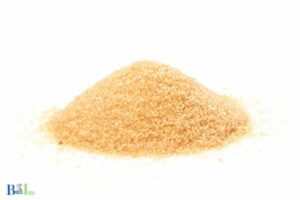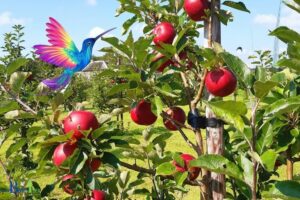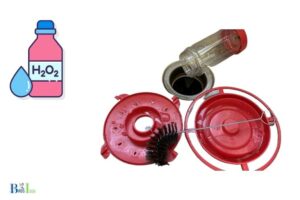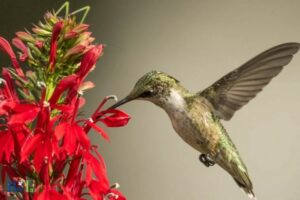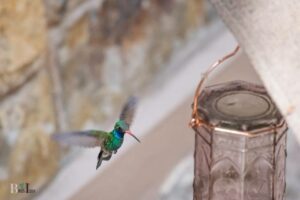Where to Hang Hummingbird Swing: Shaded Area!
Hanging a hummingbird swing should be done in a partially shaded area. Ideally, this should be in a spot that gets at least four hours of direct sunlight.
Avoid direct wind and anything that would block the sun.
Placing the hummingbird swing around trees or shrubs is a great way to ensure a comfortable spot for the hummingbirds to visit without being exposed to too much sunlight or wind.
Hanging a hummingbird swing in the right spot can make it much more inviting and comfortable for the hummingbirds to stop by and take a rest.
Doing so with the help of trees and shrubs, as well as direct sunlight and shade, can create a safe, inviting environment that is perfect for inviting and welcoming the hummingbirds.
7 Locations to Hang a Hummingbird Swing
| Location | Advantages | Disadvantages |
| Near a Feeder | Easy for hummingbirds to find, offers resting spot close to food | May attract other bird species |
| In the Shade | Provides a cool, comfortable place for hummingbirds to rest | May be more difficult for hummingbirds to find |
| Close to Windows | Allows for easy viewing of hummingbirds | Hummingbirds may collide with the window |
| Near Flowering Plants | Attracts hummingbirds by offering a natural food source | May not be close to feeding stations |
| In a Quiet Area | Reduces stress on hummingbirds | May be more difficult to observe the birds |
| Within Shrubs or Trees | Offers protection from predators and weather | May obscure view, difficult to hang swing |
| High Up | Less likely to be disturbed by pets or humans | Difficult to install and maintain |
Key Takeaway
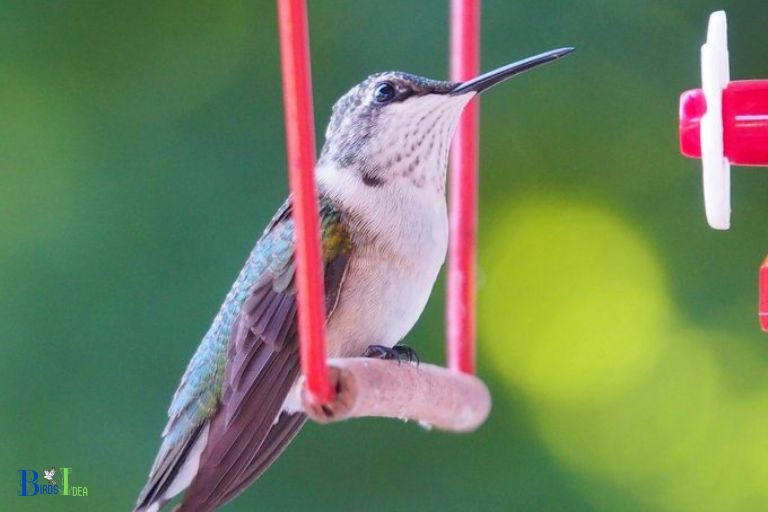
Five Facts About: Hanging Hummingbird Swings
DID YOU KNOW
Hummingbirds are the smallest birds in the world, weighing just a few grams and measuring from 2.2 inches to 4.3 inches in length.
Necessary Requirements for Hanging a Hummingbird Swing
Hanging a hummingbird swing requires special preparation and care to ensure a safe and secure environment for the bird.

Necessary Requirements:
A safe and secure location for the swing:
Choose a location that is shaded and protected from the wind. Consider windbreaks like trees or other structures to provide protection for the swing and its occupant.
Swing must be hung at least 3 feet off the ground:
Hummingbirds need to have a safe and secure space to perch and feed. Also, make sure the swing is within easy reach of their preferred food source.
Choose the right materials:
Select a swing that is made of weather-resistant materials like stainless steel or aluminium. Also, look for a swing with a wide opening to ensure comfort.
Secure the swing:
Make sure the swing is securely attached to the mounting bracket with heavy-duty wire or chain. This will ensure the swing remains stable and secure in all weather conditions.
Clean the swing regularly:
Clean the swing with a gentle soap and warm water to keep it in good condition.
By taking the time to carefully plan and prepare for the installation of a hummingbird swing, you can provide a safe and secure environment for these delightful birds.
The Original Hummingbird Swing
Ideal Spot for Hanging a Hummingbird Swing
The ideal spot for hanging a hummingbird swing is a sheltered area such as a gazebo, porch, or an arbor that is close to a food source.

To ensure the best experience, there are a few key considerations:
Hanging a hummingbird swing in the ideal location will not only provide a safe and comfortable resting spot for the birds, but it will also give you the opportunity to observe and enjoy these beautiful creatures up close.
Advantages of Placing a Hummingbird Swing Near Trees and Shrubs
Hummingbird swings provide great opportunities for birdwatchers to watch and enjoy hummingbirds up close. Placing a hummingbird swing near trees and shrubs has several advantages.

Attracts Hummingbirds:
Placing the swing near trees and shrubs is beneficial as it helps to attract hummingbirds to the area. The presence of trees and shrubs can provide shelter and a place to rest for the birds.
Provides Natural Nectar:
The trees and shrubs near the swing can also provide a source of natural nectar for the hummingbirds. This way, they can feed without having to rely on a feeder.
Protection from Predators:
The presence of trees and shrubs around the swing can provide protection to the hummingbirds. If a predator is nearby, the birds can hide in the foliage and be safe from harm.
Variety of Species:
Placing the swing near trees and shrubs can attract a variety of hummingbird species. This can make bird watching even more enjoyable as different species can be observed.
In summary, placing a hummingbird swing near trees and shrubs is a great way to attract and observe hummingbirds up close.
The trees and shrubs provide a source of natural nectar for the birds, protection from predators and also attracts a variety of different species.
“Choose a spot for your hummingbird swing as if you were choosing a spot for yourself- with safety, comfort and beauty in mind.”
birdsidea
Benefits of Direct Sunlight for a Hummingbird Swing
Direct sunlight provides a number of benefits to hummingbird swings.
Here are some of the key advantages:

Direct sunlight can be an important part of a hummingbird swing’s success. Providing these benefits can help hummingbirds to use the swings more often and to enjoy the features that they provide.
Benefits of Partial Shade for a Hummingbird Swing
Partial shade can be immensely beneficial for a hummingbird swing.
Some of the main benefits include:

Protection from the sun:
Partial shade can help protect the hummingbird swing from direct sunlight, reducing the risk of damage from UV exposure.
Temperature regulation:
The partial shade will also help regulate the temperature of the hummingbird swing, making it more comfortable and hospitable for the hummingbirds.
Reduced strong winds:
Partial shade can also help reduce the impact of strong winds that can damage the swing, as well as reduce the temperature fluctuations due to wind.
Reflection of light:
Partial shade can help reduce the glare of direct sunlight, making it easier for the hummingbirds to enjoy their swing without squinting or getting too much light.
Overall, partial shade can be an invaluable asset for a hummingbird swing, providing protection from the sun, temperature regulation, reduced strong winds, and reflection of light.
By offering the hummingbird swing with some partial shade, you can ensure that your hummingbirds have an enjoyable environment to swing in.
Tips for Attracting Hummingbirds to a Hummingbird Swing
Attracting hummingbirds to a hummingbird swing can be an enjoyable activity for bird-lovers.
Here are some tips to make your hummingbird swing more attractive to these small birds:

Provide food: Hummingbirds need an adequate food source, so make sure to provide them with nectar-rich flowers or hummingbird feeders.
Make it safe: Make sure the swing is safely located away from predators, such as cats or sharp objects that may cause harm.
Create shelter: Plant shrubs or trees nearby to provide shelter and protection from the elements.
Install a water source: Installing a shallow water source nearby can help attract hummingbirds to the swing.
Install a bird bath:Bird baths are a great way to provide birds with a place to take a bath, drink and cool off.
Following these tips can help make your hummingbird swing a more attractive destination for these beautiful and fascinating birds.
Ensuring a Safe and Inviting Environment with a Hummingbird Swing
A hummingbird swing is an excellent way to create a safe and inviting environment for children. It provides a safe, low-impact way for kids to enjoy playing outdoors.

Here are some tips for ensuring a safe experience with a hummingbird swing:
Check for Proper Installation:
Make sure that the swing has been securely mounted according to the manufacturer’s instructions and that all bolts and fasteners are tightened.
Inspect the Swing:
Ensure that all parts are in good condition, including the mounting brackets and chains, the seat, and the ropes. Replace any worn or damaged parts immediately.
Supervision:
Even with a low-impact activity such as this, it’s important to supervise children while they’re using the swing and ensure they’re not swinging too high or too fast.
Weather Considerations:
Consider the weather before allowing children to use the swing. Strong winds, heavy rains, and extreme heat can all make it unsafe to use the swing.
A hummingbird swing can provide children with a safe, low-impact way to enjoy playing outdoors. By following these tips, you can ensure that your children are safe and having fun while using the swing.
FAQ of Where To Hang Hummingbird Swing
What is a hummingbird swing?
It typically has a flexible metal rod that hangs from a hook and also has a built-in feeder holder where a hummingbird feeder can be attached.
Where is the best place to hang a hummingbird swing?
It is also best to hang the swing in a sheltered area that is away from wind and rain.
How high should a hummingbird swing be hung?
Is a hummingbird swing safe for other birds?
What type of feeder holder is best to use with a hummingbird swing?
These feeder holders are usually made of stainless steel to ensure durability and secure the feeder to the swing.
Conclusion
When seeking to hang a hummingbird swing, the best spot to choose is one that gets at least four hours of direct sunlight and has ample shelter from wind and anything blocking the sun.
Adding trees and shrubs to the area can be a great way to provide additional shelter and a pleasant environment for the hummingbirds to visit.

